Start Roller Skating for Beginners in 9 Easy Steps
Have you always wanted to learn how to roller skate but were either too afraid to try or just didn’t know how to get started? Then, this blog post is for you!
Today, I will go over everything you need to do to go from roller skating newb to a pro skater. Okay. Maybe you won’t be a pro when you are done reading this, but you will be ready to lace up those skates, head to your local roller skating rink and have some fun, too!
In this article, I go over step-by-step how to roller skate for beginners. I have a variety of ways for you to learn.
- For visual learners: Check out the videos below where I go step-by-step through the process. I have a description of each step below along with skating videos of me performing each step.
- For auditory learners: Check out my Roller Skate for Beginners podcast episodes. I detail all of the content in this article (and more) in each episode and you can listen while you skate!
- For readers: Each step below is detailed step-by-step.
Wanting to learn how to use rollerblades or inline skates? Check out my How to Rollerblade article. It’s very similar to this article except geared towards inline skates. And if you’re not sure which type of skates are best for you, check out my article Comparing Rollerblades vs Roller Skates vs Inline Skates.
How to Roller Skate Step-by-Step
1. Sit on the Floor and Put Your Skates On

First, start by sitting on the floor. Grab your first skate and put it on. Next, lace up your skates. I like to make my skates tight enough so the skate feels secure but not so tight that the circulation gets cut off and I can’t feel my foot anymore. 🙂
Seriously, though, you want your skates tight so you feel secure when you are skating. Tie them just like a pair of shoes. If you have high top skates, which I recommend for beginners, then make sure that as you lace to the top of the skate it is tight. Then, I usually tie a nice bow and double knot it just so it doesn’t come undone.
2. Practice Getting to Your Feet & Falling Down
Now that your skates are on, lets practice standing up and falling down.
Practice Standing Up

- First, head over to a carpeted area in your house or onto a nice patch of grass. Make sure the space is flat.
- Next, spin your body around and kneel on both knees.
- Then, take a knee – all Tim Tebow like. Bring one leg up and have the other knee on the ground.
- Next, put your hands on your lifted leg and push down on your leg as you stand.
- Now, make sure you keep your knees slightly bent and lean slightly forward. If you fall, you want to fall forward – never backwards if you can help it.
- If you are rolling unexpectedly when you stand up, stand instead in a t position. The T position looks just like it sounds. You turn 1 leg 90 degrees and place it behind your front foot with one foot facing forward and the other skate facing out. This position will keep you from rolling.
- Stand straight keeping your upper body centered over your skates with a slight lean forward and your knees bent.
- Next, practice putting yourself back into a kneeling position by bending one of your legs and slowly moving down to 1 knee.
- Repeat this process over and over again on carpet or grass outside where you will not roll. Skating is all about balance. Once you master balance, it gets a whole lot easier.
Practice Falling Down
You may ask, “Why do we practice falling down?” Simple. Because the more you practice falling down the better you’ll get at it. Everyone falls sometimes when they skate – even me and I have been skating for almost as long as I have been walking.
Drop to One Knee

- Stand up on your skates.
- With your knees bent and your feet shoulder width apart, slowly drop down to one knee.
- Now, in the one knee position, stand back up.
Fall Forward on 2 Knees
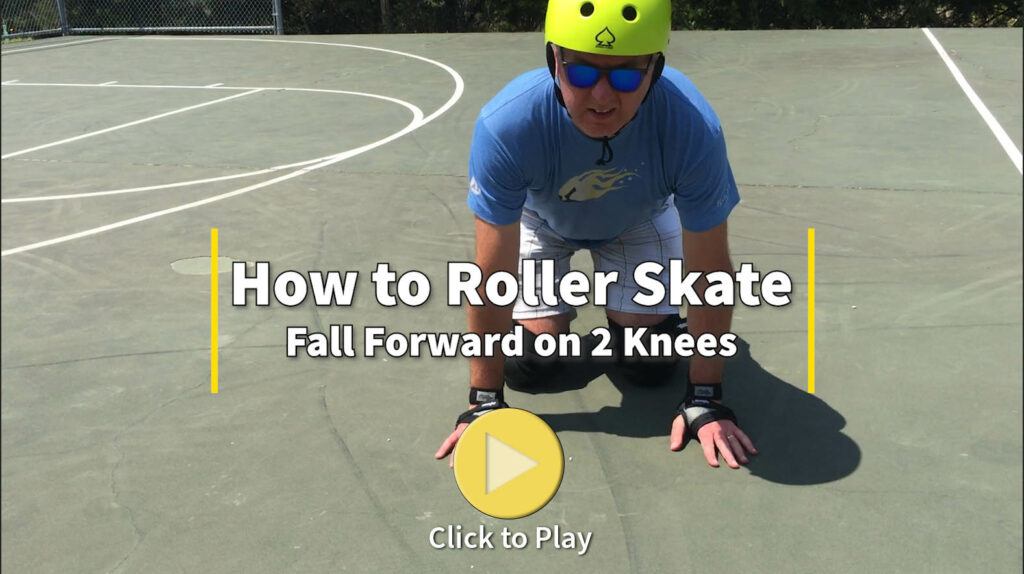
When you are roller skating, you are going to fall. It’s just going to happen. And while preparing for a fall by taking a knee sounds great, it just isn’t going to be possible to predict every fall. So, lets talk about and practice falling forward.
- Stand up on your skates
- Next, stand in the skating posture (knees bent) and lean your body slightly forward.
- Then, fall down onto both knees and lean forward as you fall.
- Your hands will come down onto your wrist guards. If you fall haphazardly, you may also bang an elbow pad onto the ground.
When you fall forward, try to have your pads take the brunt of the force. Wrist and knee pads are pretty much a necessity when you are first learning because most people fall forward on their hands and knees.
3. Getting Up from a Chair or Bench
Next, let practice getting up from a seated position from a chair or bench.
- Turn your legs to the side of the bench or chair.
- Use the back of the chair or bench as support to balance yourself as you stand.
- Continue to use the back of the chair or bench for support.
4. How to Use Your Toe Stoppers
Next, lets practice the toe stop drag without rolling.

- First, get onto some carpet or grass. If that’s not available, stand in a T position to keep your feet from rolling.
- Then, take your back leg, lift your heel and point your back foot down until your stopper touches the ground.
- Next, return your back leg to it’s starting position.
- Practice this over and over again. You want to get good and understanding this feeling when you are not rolling first.
- Later, after you get rolling, practice dragging your stopper as you roll. It’s the exact same motion as before, except now you are rolling. Drag your toe stop until you come to a complete stop.
5. Posture and Taking Your First Steps
Next, lets practice the right posture or what I like to call skating posture.
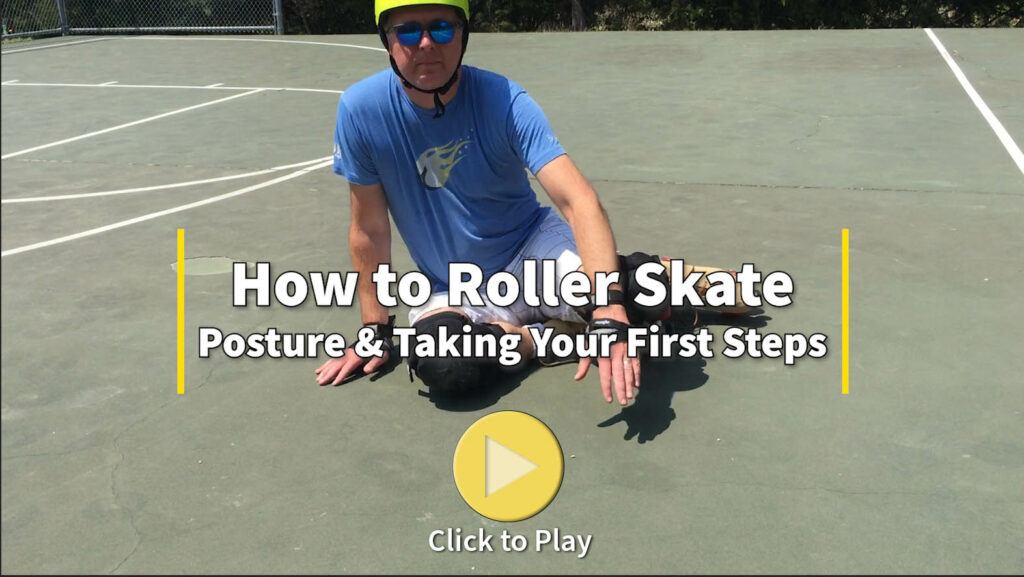
- First, bend your knees. Put your skates next to each other a little closer than shoulder width apart.
- Next, lean slightly forward. Keep the muscles in your core tight. You want your body weight to be towards the front center of your skates (more leaning forward than backwards). You should feel your thigh muscles engaging from the bend and slight lean forward. Do not stand like a straight legged mummy please!
- Next, you can turn your toes inwards slightly if you are rolling. This will also insure you don’t roll backward.
- Feel free to shoot your arms out from your side in a T shape for balance.
- Next, walk around in your skates on the carpet or grass. Get comfortable walking in your skates without them rolling. If you can’t find carpet or grass, you can always tighten the nut on the end of your wheel. The tightening of this nut on most skates will keep the wheel from rolling.
6. Balance is the Key
Practice Standing on One Foot with Skates
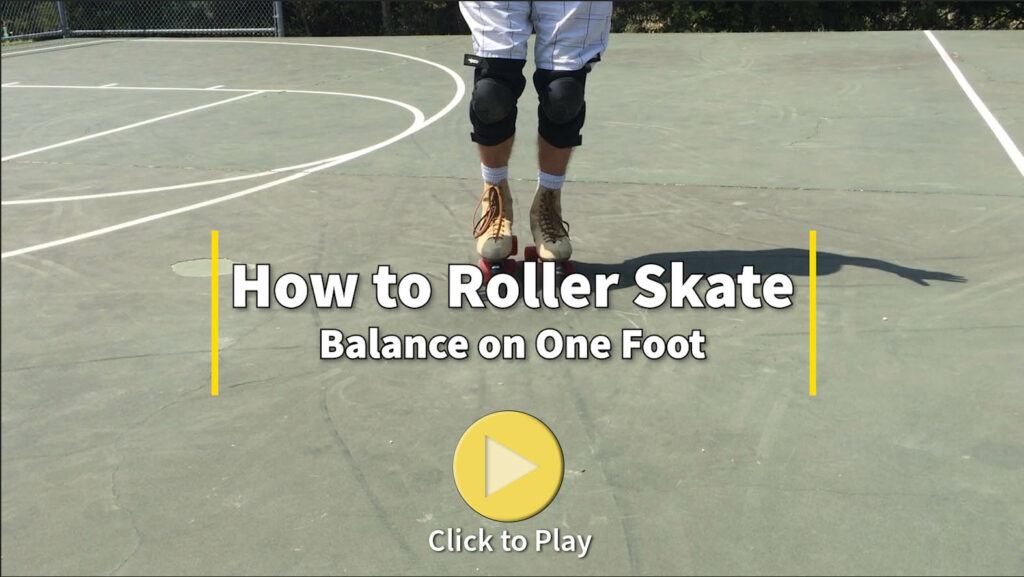
Superior balance is the key difference between beginner skaters and experienced skaters group. More experienced skaters are fabulous at balance. To start, lets practice standing on a single foot with your quad skates on. Again, do this on carpet or grass so you don’t roll.
- Stand in the skating position with bent knees and a slight lean forward.
- Now, pick up one skate from the ground and lift your foot.
- Balance on your other leg for a count of 5 seconds.
- Then, place your foot down and switch to the other foot.
- It is completely normal for this to be hard when you are first starting out. Many people just do not have good balance. If this is you, don’t worry. It just may take you a little more practice to get good at balance. So, instead, practice all of the above but without skates on. When you get good at balancing without skates, then try it again with skates on.
7. Gliding – Forward Skating like a Pro!
Now, lets get to gliding – or what we call skating.
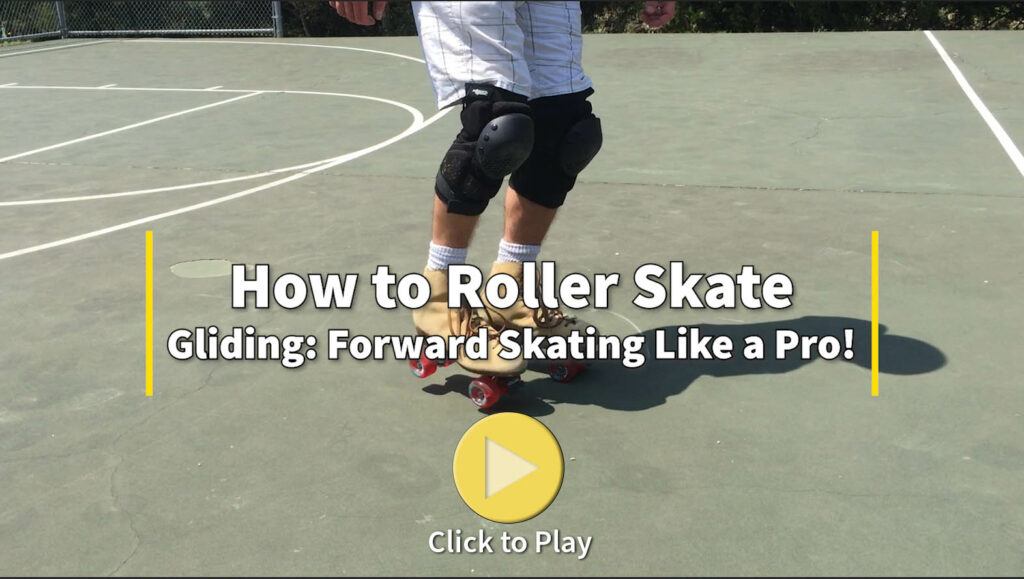
- Stand in the skating position with bent knees and leaning slightly forward.
- Now, stand on your dominate leg and push with your other leg.
- Take a baby push to start. Turn your leg 45 degrees, have all 4 wheels on the ground and push.
- Put the leg you pushed with back down on the ground. You should now be rolling slowly forward.
- When you start to lose momentum, repeat the steps above and push again.
- Keep paying attention to your body posture. If you start to shake, you can always use your toe stop to slow down. Also, feel free to take a knee if you get tired.
- Keep practicing pushing side to side and rolling forward. As you get more comfortable, you can use more power in your pushes to go faster.
8. If You are Completely Out of Control on Your Skates

If you have been following along and you are just completely out of control on your skates, then these tips may help:
- Move to the carpet or grass – When your wheels can’t roll, its really a lot easier to get used to your skates and not get hurt. Move to carpet or grass when you first start and you will get more comfortable in your skates faster.
- Tighten Your Wheels and Walk in Your Skates – Another trick is to tighten the nut that secures your wheel to your plate. If you tighten this nut on most skates, your wheels will eventually stop rolling. Now, your skate is just a big, tall, heavy shoe. Practice walking around in your skates to get used to them. I have taught 1000s of little kids (2-3 year olds) to skate using this trick. It works.
- Bad Balance – If you have tried everything, then I have one word for you. Yoga. Yep, it works. And trust me, I didn’t like yoga. Not me. I’m a manly man. It may take you months (or even years), but start practicing and you will find balance (in more way than one). It’s free, check out Yoga with Adriene on YouTube, and it’s totally awesome for you. This will go a long way in helping you out in a lot of things in life including stress reduction, balance, flexibility, better mood, weight control, etc.
- Find a Roller Rink (or an Experienced Skater) and Ask for Help – If you are really struggling and thinking about quitting, please reach out for help. I know not everyone has a roller skating rink around them, but if you do, they are usually a great resource for roller skating lessons.
9. Practice Regularly
As with every new activity in life, practice make perfect. Many beginners want to know how often they need to practice to get good. The simple answer is practice as often as you can.
Picking out the Right Roller Skates
Before you can get started roller skating, it’s important first to have a pair of roller skates. If you already have a pair of skates, then you are good to go! If not, then check out my article on the the Best Roller Skates for Beginners. In it, I go over all of the parts of a roller skate and what to look for in good beginner roller skates.
If you instead interested in inline skating and want to get the best inline skates available, then check out my Best Rollerblades page.
Protect Yourself – Getting the Right Roller Skate Protective Gear
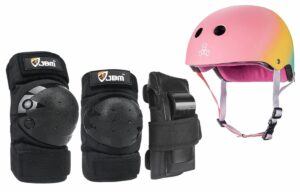
Now that you have your roller skates in hand, lets talk about protecting yourself. We’re going to cover all of the roller skating pads and roller skating helmets that every beginner roller skater needs to get started.
The most important pads to get are knee pads, elbow pads and wrist guards. If you want to protect your tailbone, then check into a butt pad (or padded shorts). You can read all about pads in my Best Roller Skate Pads article.
Last but not least is the helmet. Please wear one especially if you are park skating or skating outdoors. It’s hard to know when a loose pebble is going to send you down. You can read all about the Best Roller Skate Helmets here.
More Training: The Roller Skate for Beginners’ Podcast
I have put together some how to roller skate for beginners podcast episodes to help you get started. You can listen to them right here on this page or listen while you’re skating on your favorite podcasting apps.
Part 1: The Skater’s Mindset
Part 2: Tips for Picking Out Your First Roller Skates (1 of 2)
Part 3: Tips for Picking Out Your First Roller Skates (2 of 2)
Part 4: Choosing Your First Roller Skates
Part 5: Picking Out Your Safety Gear
Part 6: Falling Down & Getting Back Up
Part 7: Learn How to Stop on Roller Skates
Part 8: Skating Forwards without Falling Down
Part 9: Balance, Standing on One Foot & Crossovers
Part 10: Roller Skating Backwards
Part 11: Doing Backwards Crossovers
Part 12: Doing Two Foot Turns
Part 13: Doing One Foot Turns
Part 14: Doing the Bunny Hop
Part 15: Doing a Waltz Jump
Part 16: Doing Two Foot Spins
FAQ
How often and where should I practice?
You should practice as much as possible. The more you practice, the better you will get and the quicker you will improve. The best places to practice roller skating nearby include your garage, the sidewalk, the park, a skate park and my favorite, the skating rink.
What are the best roller skates for a beginner?
My favorite beginner roller skate are the Sure-Grip Boardwalk skates. These are my favorite for a few reasons. They are affordable. They have soft, outdoor wheels on them which are better for beginners. They have high-top boots that are also better for beginners. Check out my 10 Best Roller Skates for Beginners article for more.
